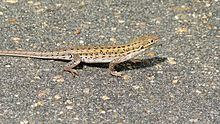Kingdom Animalia Class Reptilia Infraorder Scincomorpha Phylum Chordata Rank Species | Subphylum Vertebrata Suborder Sauria or
Lacertilia Family Lacertidae Genus Meroles Order Scaled reptiles | |
 | ||
Similar Scaled reptiles, Meroles, Heliobolus lugubris, Nucras, Heliobolus | ||
Meroles squamulosa is a species of African lizards originally placed in the genus Ichnotropis, however phylogenetic evidence moves this species to the genus Meroles. The species is commonly called common rough-scaled sand lizards and is largely found in southern Africa. These lizards are terrestrial and found in the range of mesic savannah. The common rough-scaled lizard is medium in size and well distributed in parts of Namibia, Botswana, Zimbabwe, Angola, Tanzania, and Zambia.
Contents
Description
The common rough-scaled lizards are medium-sized lizards each with a small head, body, and a long tail. The frontonasal is divided and has small body scales in 42 to 58 rows at the midline. The backs of these lizards are brownish grey with narrow dark blotches and rows of pale spots. These lizards share characteristics of the genus Ichnotropis.
Identification of Ichnotropis includes the following:
Unlike the Ichnotropis, M.squamulosa does not have subocular scales bordering the lip.
Habitat
The rough-scaled lizards can be found in semi-arid, shrub savannas in Africa such as Ngamiland, Botswana. They dig branching burrows in the soft sand usually at the base of Acacia trees that may be shared with several individuals.
Biology
These lizards are insectivorous and actively hunt during the day feeding on termites, grasshoppers, beetles and other small insects. They seem to have a sympatric relationship with Ichnotropis capensis as their mating season alternates so they do not compete for the same resources.
Taxonomy and evolution
Based on morphological evidence from the capensis species the South African genus Ichnotropis and the North American genus Psammodromus diverged from the lineage of Lacerta lepida and Lacerta monticola during the Oligocene epoch (24 to 36 million years ago).
Since 1854, the squamulosa species was classified under the genus Ichnotropis and that classification was determined through morphological characteristics. More recent molecular phylogenetic analysis of mitochondrial DNA and nuclear DNA markers determined that Ichnotropis squamulosa did not group with Ichnotropis, but with the genus Meroles. Morphological traits can change over time influenced by factors such as microhabitat and environment or a combination of factors. Phylogenetic evidence of I.squamulosa was found in 2007, but was not accepted due to incomplete taxon sampling for Ichnotropis.
Mating
This lizard has a life expectancy of 8 to 9 months. The males have a symmetrical armatured hemipenes which only one is used at a time. The males and females have 11 to 18 femoral pores on each thigh of which pheramones are commonly excreted. The females lays 8 to 12 eggs around April or May and hatchlings appear from October through November. The long incubation period is due to the cold conditions of winter. Growth is rapid as these lizards reach sexual maturity in 4 to 5 months.
Helminths
I. squamulosa is one of 8 genera of lizards in southern Africa that have been reported to harbor helminths These helminths have a paratenic relationship with these lizards using them to transport and infect others.
